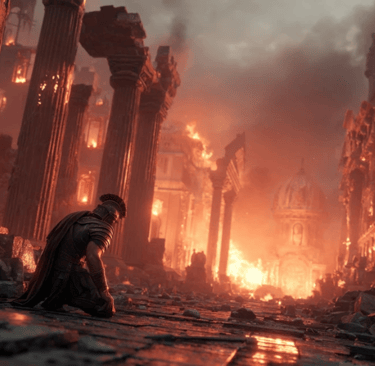Did the Roman Empire Really Fall? The Truth Behind History’s Biggest Collapse
The fall of the Roman Empire wasn’t the end — it was a transformation. Discover how Rome survived, evolved, and shaped the modern world.
5/8/20244 min read
Watch the Full Story Unfold on YouTube

Curious to see how Rome’s “fall” really happened?
Watch our full video on YouTube and dive deeper into the myths, truths, and transformations that shaped the Roman Empire’s legacy.


Did the Roman Empire Really Fall? Rethinking One of History’s Biggest Myths
Ask almost anyone when the Roman Empire fell, and you’ll hear one date: 476 AD.
It’s taught in classrooms, printed in textbooks, and reinforced by popular culture. Rome, we’re told, collapsed when barbarians sacked the city, bringing the greatest empire in history to a violent end.
But what if that story isn’t entirely true?
What if the Roman Empire didn’t really fall — at least, not the way we’ve been taught?
Let’s take a closer look at what actually happened… because the truth is far more complex, and a lot more fascinating.
476 AD: The Date That Doesn’t Tell the Whole Story
Yes, something important did happen in 476. A Germanic general named Odoacer deposed Romulus Augustulus, the last emperor of the Western Roman Empire. Historians often mark this event as the “official” fall of Rome.
But here's the thing — life didn’t suddenly stop.
Cities didn’t all burn. Roads didn’t vanish. Roman citizens didn’t wake up the next day in a completely new world. In fact, many probably didn’t even notice a dramatic shift in power at first.
Because Rome didn’t fall overnight. It slowly transformed — over centuries.
The Empire That Lived On: Byzantium
While the Western Roman Empire weakened, the Eastern Roman Empire — later known as the Byzantine Empire — continued to thrive. Its capital, Constantinople (modern-day Istanbul), became one of the most powerful, wealthy, and beautiful cities in the world.
The Byzantines considered themselves Roman, even a thousand years after the fall of the West. Their emperors, armies, and churches were steeped in Roman law, tradition, and identity.
Walk into the magnificent Hagia Sophia today, and you’re stepping into a Roman legacy. Gaze at its mosaics and domes — that’s Roman architecture, reimagined for a new era.
The truth? The empire didn’t die. It evolved.
Barbarians or… Romans?
One of the most dramatic images of Rome’s collapse is the “barbarian invasion.”
We picture wild warriors storming through Roman gates, burning everything in sight. But the reality was much more complicated.
Many so-called “barbarians” were actually Roman citizens. They served in the Roman army. They traded with Roman merchants. Some even rose to high ranks within Roman politics.
Groups like the Visigoths, Ostrogoths, and Vandals had been living on the empire’s borders for generations. They were sometimes allies, sometimes enemies — and often both at once.
Rome didn’t fall because it was invaded by strangers.
It changed because the lines between Roman and barbarian blurred. The empire became too large, too complex, and too divided to manage.
Corruption, Civil Wars, and a Shaky Economy
If there was a real cause for the empire’s decline, it wasn’t just outside forces — it was what was happening within.
By the 3rd and 4th centuries, Rome had become a political mess.
Emperors were assassinated regularly.
Generals fought each other for power.
Civil wars drained resources and morale.
Inflation and heavy taxes crushed the economy.
The population shrank due to disease and unrest.
It’s hard to rule the world when your own house is crumbling.
And Rome’s internal cracks ran deep.
From Legions to Knights: Transformation, Not Collapse
After 476 AD, Roman legions didn’t just vanish. In many regions, they gradually became part of medieval armies.
Roman forts became castles. Roman roads became trade routes. Roman law influenced medieval codes. And Roman ideas of citizenship, governance, and infrastructure never truly disappeared.
Over time, Latin-speaking Romans gave way to Romance-speaking Europeans — and the seeds of modern nations were planted in the soil of the old empire.
The Middle Ages weren’t a reset. They were a remix.
Rome Is Still With Us
If you live in a city with straight roads, centralized government, running water, or public architecture, you’re living with Rome’s legacy.
Aqueducts still carry water under modern cities.
Latin lives on in languages like Spanish, French, and Italian.
Civil law systems in Europe and beyond trace their roots to Roman law.
Architecture in Washington D.C., London, and Paris owes everything to Roman arches and columns.
Even the idea of a Senate, a Republic, or a citizen’s right to vote? That’s Rome.
Rome isn’t just ruins. It’s in our DNA — socially, politically, and culturally.
Why This Myth Persists
So why does the myth of Rome’s sudden fall stick around?
Because it’s dramatic. It’s easy to teach. And stories of catastrophe tend to stick more than stories of slow change.
But history rarely fits into neat boxes.
The truth is usually more layered, more human, and more interesting.
The Real Legacy of Rome: Survival Through Change
Rome’s greatest achievement may not be its military conquests or monuments — but its ability to adapt.
Its language evolved.
Its religions adapted.
Its laws, ideas, and institutions spread and survived.
The Roman Catholic Church, for example, preserved Roman structure, rituals, and influence long after emperors stopped ruling.
The Byzantine Empire carried on Roman legacy until 1453.
And today, Rome lives on in our cities, our systems, and our stories.
Rethinking History: It Didn't End. It Transformed.
If you came here expecting to read about fire, destruction, and barbarians — surprise.
The story of Rome’s “fall” is less about collapse and more about transformation.
It’s the story of an empire that morphed, splintered, and scattered, but never quite died.
It’s still with us — under our feet, in our words, in our laws, and in the very shape of the world we live in.
So the next time someone asks you when the Roman Empire fell, ask them this:
Did it ever really fall?
Ready to Rethink Everything You Thought You Knew About History?
At Phylosia Discovery, we uncover the stories that time forgot — from powerful lost civilizations and ancient African innovations to the science and myths buried beneath the surface.
If you're curious about the real legends, hidden truths, and surprising knowledge that shaped our world...
Join us.
We release new videos every week exploring the mysteries of the ancient world — empires, ideas, and discoveries that still shape how we live today.
Subscribe now on YouTube and rediscover the past through a new lens.
Because history isn’t just what survives —
It’s what we choose to explore.
Explore
Discover the world of phylosia through articles.
Shop
Contact Us
© 2025. All rights reserved.
